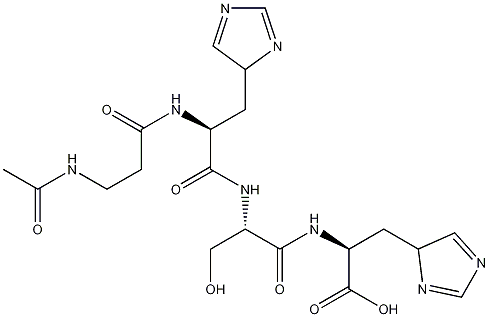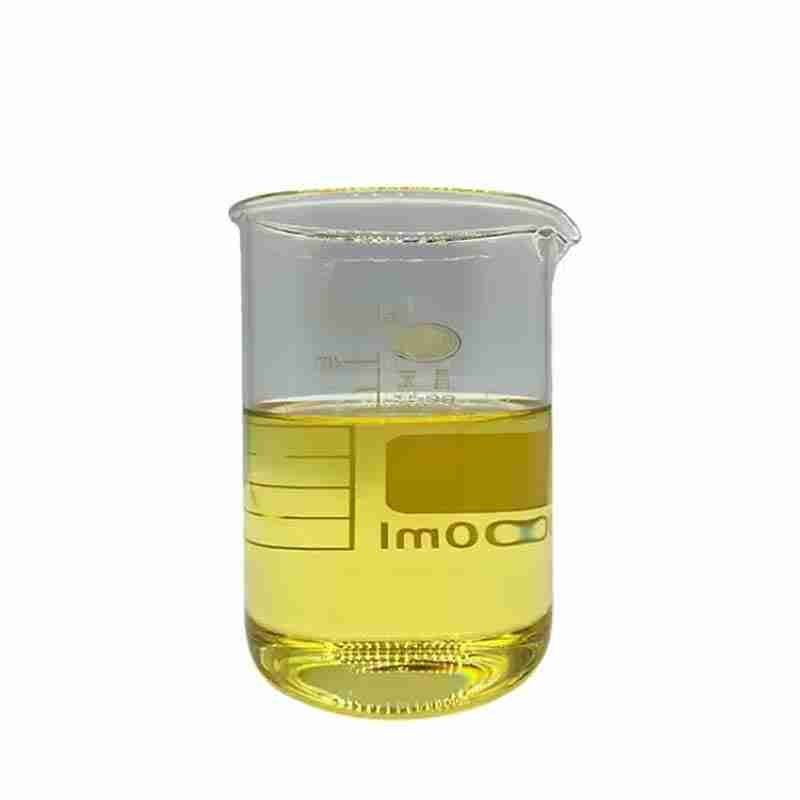Acetyl Tetrapeptide-5 CAS# 820959-17-9
Acetyl Tetrapeptide-5 is a white to cream coloured powder. The active ingredient is used to treat lachrymal sacs and dark circles under the eyes. It stimulates cell metabolism, improves skin elasticity, reduces puffiness and water retention in the eye area and makes the skin supple.Acetyl tetrapeptide-5 inhibits collagen glycation avoiding skin losing elasticity and subsequent eyebags formation .
Acetyl tetrapeptide-5 prevents liquid accumulation in eyebags .
Acetyl tetrapeptide-5 shows a slight lightening effect which decreases dark circles under the eyes Use level: 0.01 %, maximum 0.1 % (water soluble)
发送询盘
Acetyl Tetrapeptide-5 CAS# 820959-17-9
| Acetyl Tetrapeptide-5 Basic information |
| Product Name: | Acetyl Tetrapeptide-5 |
| Synonyms: | N-Acetyl-beta-alanyl-L-histidyl-L-seryl-L-histidine;Acetyl tetrapeptide-5;Acetyl Tetrapeptide;Depuffin/Acetyl Tetrapeptide-5;Acetyl Tetrapeptide-5/eyeseryl;Depuffin;tetrapeptide;Eyeseryl / Acetyl Tetrapeptide-5 |
| CAS: | 820959-17-9 |
| MF: | C20H28N8O7 |
| MW: | 492.49 |
| EINECS: | 1312995-182-4 |
| Product Categories: | BEAUTY PEPTIDES;APIs;820959-17-9 |
| Mol File: | 820959-17-9.mol |
 |
|
| Acetyl Tetrapeptide-5 Chemical Properties |
| Boiling point | 1237.3??65.0 ??C(Predicted) |
| density | 1.443 |
| storage temp. | 2-8??C |
| solubility | PBS (pH 7.2): 10 mg/ml |
| form | A crystalline solid |
| pka | 2.76??0.10(Predicted) |
| color | White to off-white |
| InChIKey | RIUMNDWYYDHBFO-UDJPXWLSNA-N |
| SMILES | C(O)(=O)[C@H](CC1N=CN=C1)NC(=O)[C@H](CO)NC(=O)[C@H](CC1N=CN=C1)NC(=O)CCNC(C)=O |&1:3,13,19,r| |
- 2
- 2-diallylpent-4-en-1-amine
- 4
- 95-16-9
- Ammonium sulfamate
- Benzothiazole
- cas:67889-00-3ح2
- cas:83524-75-8 | pigment black 32
- cas:928836-00-4 | 2
- cas:932745-70-5 | 4
- Chemical Minerals
- Coconut diethanolamide
- Daily Chemicals
- discount
- for sale
- General pvc resin
- hexyl D-glucoside
- in stock
- Lauramidopropyl betaine
- LAURIC ACID MONOETHANOLAMIDE
- Petroleum Additives
- Plasticiser
- Ploymers
- price
- PVC
- quotation
- Raw Materal
- Remove term: Petroleum Additives Petroleum Additive
- SODIUM ETHYL 2-SULFOLAURATE
Related Products
Chemical Name: 1,1,2,2-Tetrachloroethane
Other Name: Tetrachlorethane
CAS No.: 79-34-5
Molecular Formula: C2H2Cl4
Molecular Weight: 167.85
Appearance: Liquid
Common English name: 5-iodo-2,3-dihydropyridazin-3-one
CAS No.: 825633-94-1
Molecular formula: C4H3IN2O
Molecular weight: 221.98
Sample: Available
Chemical Name: Choline salicylate
CAS No.: 2016-36-6
Molecular Formula: C12H19NO4
Molecular Weight: 241.28
Appearance: Red-Brown Crystal
Chemical Name: Quercetin-3-O-sophoroside
CAS No.: 18609-17-1
Molecular Formula: C27H30O17
Molecular Weight: 626.52
Chemical Name: o-Xylene
Synonyms: 1,2-Dimethylbenzene; ortho-xylene
CAS No.: 95-47-6
Molecular Formula: C8H10
Molecular Weight: 106.17
Silicone oil, known for its chemical designation as dimethicone or polydimethylsiloxane, is a synthetic polymer with a backbone of alternating silicon and oxygen atoms, creating a highly versatile and stable compound. It is renowned for its exceptional lubricating properties, heat resistance, and non-toxic nature, making it a staple in various industries, including cosmetics, automotive, and aerospace.
This hydrophobic, non-volatile oil is valued for its ability to provide a smooth, non-greasy feel and to form stable emulsions with other ingredients. In personal care products, silicone oil is used to impart a silky texture, reduce friction on the skin, and create a protective barrier against environmental stressors without clogging pores.
Silicone oil’s chemical inertness and resistance to oxidation contribute to its long shelf life and stability in formulations. It is also appreciated for its compatibility with a wide range of substances, allowing for the creation of multifunctional products.
In summary, silicone oil is a reliable and multifaceted ingredient, offering a combination of performance, safety, and sensory benefits. Its use in a variety of applications reflects its versatility and enduring appeal in the marketplace.
Product name:Cyclopentane
Purity:96%
Appearance:White powder
Package:25kg/bag
Sample:Available
Chemical Name: STODDARD SOLVENT
CAS No.: 64742-88-7
Appearance: Colorless or Light Yellow Liquid
Chemical Name: Dehydrocholic acid
Synonyms: Acide dehydrocholique; Triketocholanic acid
CAS No.: 81-23-2
Molecular Formula: C24H34O5
Molecular Weight: 402.53
Appearance: Powder
1-Octanol, also known as Capryl alcohol or n-Octanol, is a clear, colorless liquid with a characteristic waxy odor. It is an alcohol with eight carbon atoms in its chain, making it a part of the aliphatic alcohol family. This compound is poorly soluble in water but is miscible with ethanol, diethyl ether, and chloroform . It has a melting point of approximately -15??C and a boiling point of around 196??C . 1-Octanol is used in the production of esters, plasticizers, and as a solvent or intermediate in the synthesis of various organic compounds. It also finds application in the fragrance industry as a fixative in perfumes and can be used in the formulation of flavor and scent compositions . It is important to note that 1-Octanol is flammable and should be handled with care, storing it away from sources of ignition and heat .
Chemical Name: Ammonium Iron(II) Sulfate
Synonyms: Diammonium iron bis(sulphate); iron (ii) ammonium sulfate
CAS No.: 10045-89-3
Molecular Formula: FeH5NO4S
Molecular Weight: 170.95
Butylated Hydroxytoluene (BHT) is a synthetic phenolic antioxidant commonly added to foods, cosmetics, and packaging to prevent the oxidation of fats and oils, thereby extending their shelf life. It is also used as a preservative in a variety of products, including rubber, petroleum products, and animal feed. BHT is recognized for its effectiveness in maintaining nutrient levels, color, flavor, and odor in food products . It is known to have a melting point of 69-71??C, a boiling point of 265??C, and is soluble in ethanol, acetone, and benzene, but not in water, glycerin, or propylene glycol . BHT is also used in some dietary supplements due to its antioxidant properties . However, it is important to handle BHT with care, as it can cause skin irritation and is considered harmful if swallowed .


















